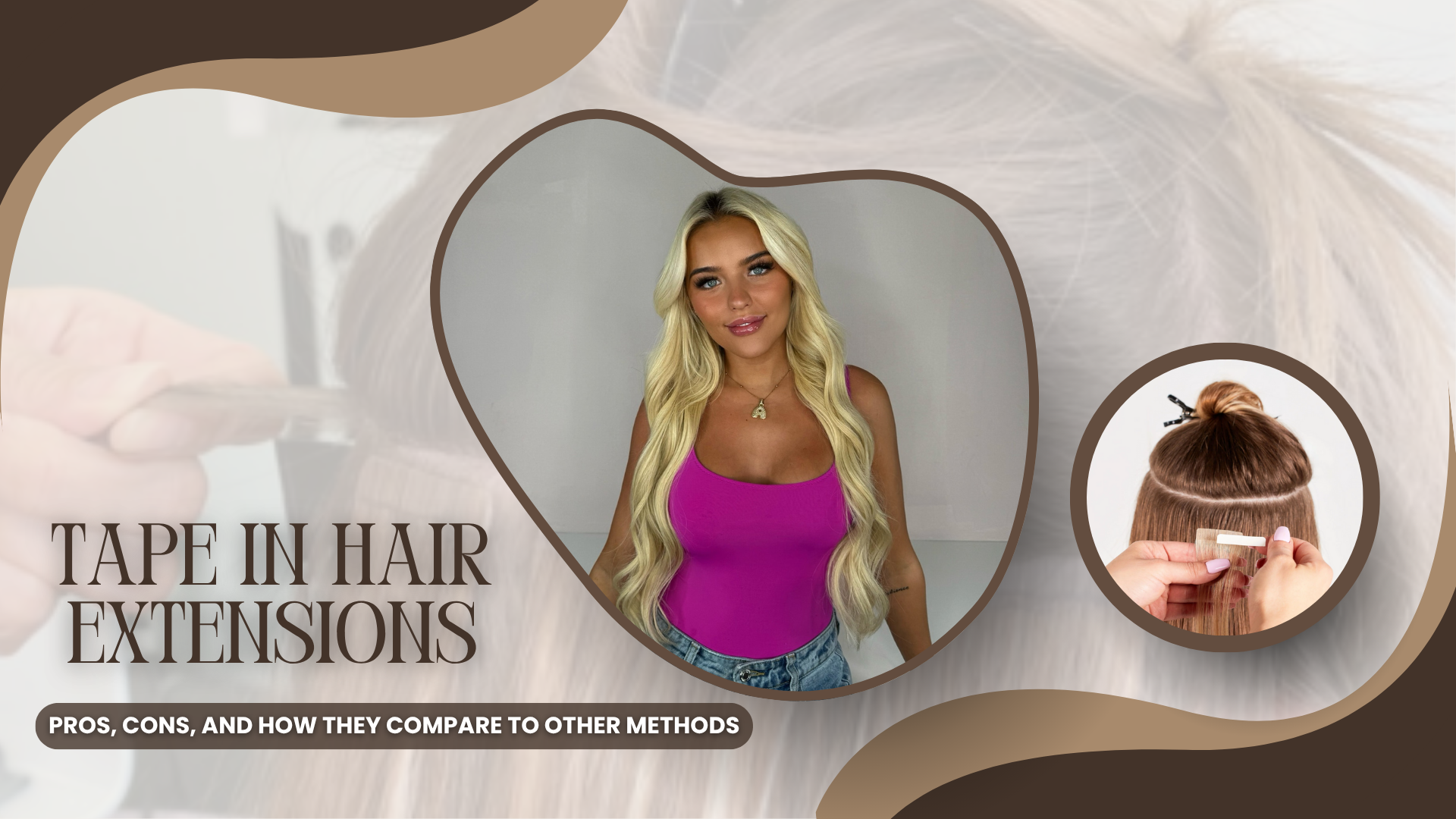If you’ve been eyeing longer, fuller locks but don’t fancy the wait for your natural hair to grow, tape in hair extensions might just be your secret weapon. Whether you’re browsing online or visiting a local hair extension salon, you’ll soon find they’re one of the most talked-about methods in the beauty world—and for good reason.
But with all the different types out there (clip-ins, micro-rings, sew-ins—you name it), how do tape-ins really stack up? In this guide, we’ll walk you through the ins and outs of tape in hair extensions, weighing up the pros, cons, and how they compare to other popular methods. So, whether you’re a total newbie or thinking about switching extension types, this blog’s got you covered.
What Are Tape In Hair Extensions?
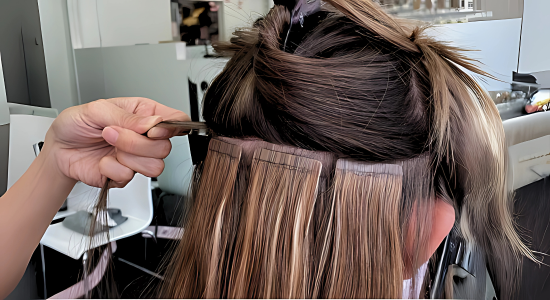
Tape in hair extensions are exactly what they sound like—sections of real human hair that come pre-taped with a medical-grade adhesive and are “sandwiched” around small sections of your natural hair.
They’re semi-permanent, meaning they can last several weeks before needing maintenance or reapplication, and they blend in beautifully when installed correctly. Most hair extension salons recommend professional application for best results.

The Pros of Tape In Hair Extensions
Let’s kick things off with the reasons why tape-ins have gained so much popularity.
1. Quick and Easy Application
One of the biggest selling points of tape in hair extensions is how quickly they can be applied. A full head usually takes under an hour at a salon—much quicker than methods like sew-ins or micro-rings.
So, if you’re after a glamorous transformation without sitting in the chair for hours, tape-ins are a time-saving dream.
2. Natural Look and Feel

Because the extensions lie flat against your head, they’re discreet and blend seamlessly into your natural hair. There’s no bulky base, and the hair flows freely—ideal if you want a natural-looking result.
With proper colour matching and styling, most people won’t even notice you’re wearing hair extensions.

3. Gentle on the Hair (When Applied Correctly)
Tape-ins are considered one of the least damaging semi-permanent options. The adhesive spreads the weight of the hair across a larger area, reducing strain on individual strands.
When applied and removed properly—by a qualified stylist—they’re far less likely to cause breakage or thinning.
4. Reusable (With Proper Care)

Good quality tape in extensions can be reused multiple times. You’ll just need to replace the adhesive strips and have them reapplied every 6–8 weeks as your natural hair grows out.
This makes them more cost-effective in the long run compared to some other methods.

5. Lightweight and Comfortable
Unlike heavier extension types that can feel tight or tug at your scalp, tape-ins are lightweight and comfortable for most wearers. Many people forget they’re even wearing them after a day or two.
The Cons of Tape In Hair Extensions
As with anything, tape in hair extensions does come with a few drawbacks. Here’s what to keep in mind before you take the plunge.
1. Require Regular Maintenance
Tape-ins are semi-permanent, so they’ll need adjusting every 6–8 weeks to move them up as your natural hair grows. Neglecting this can lead to matting, tangling, or tension on the roots.
They’re not exactly “set it and forget it” hair.
2. Not Ideal for Very Oily Hair or Sweaty Lifestyles
If you work out daily, have naturally oily hair, or use oil-based products, the adhesive might not hold as well. Excess oil can cause the tapes to slip or break down prematurely.
In these cases, a different method (like micro-rings or sew-ins) might be better suited.
3. You’ll Need to Be Gentle When Washing and Styling
You’ll have to avoid sulphate-heavy shampoos and conditioners, which can loosen the adhesive. Brushing too roughly or using too much heat can also affect the longevity of the extensions.
So, they do require a bit more TLC than your average hair routine.
4. Can Be Visible in Certain Hairstyles
Because the tapes are wider and sit flat, they may show through in high ponytails or updos if not placed strategically. A professional stylist will know how to work around this, but it’s something to consider if you wear your hair up a lot.
Tape In Hair Extensions vs. Other Extension Methods
Now, let’s compare tape-ins to some other popular options. Which is best really depends on your lifestyle, budget, and hair type.
Tape-Ins vs. Clip-In Extensions: Which One’s Right for You?
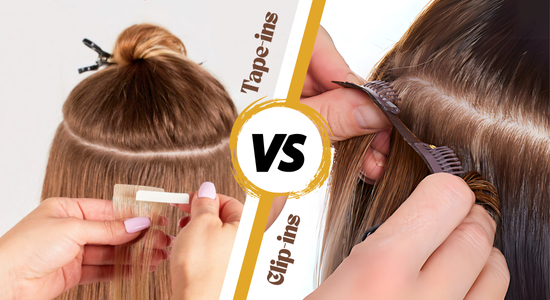
Trying to decide between tape-in and clip-in hair extensions? You’re not alone—it’s one of the most common dilemmas people face when looking to switch up their style.
Tape in extensions are semi-permanent and applied at a hair extension salon, taking about an hour. They last 6–8 weeks and offer a natural, seamless look with minimal daily effort—perfect if you don’t mind a bit of upkeep.
Clip-ins, on the other hand, are temporary and super easy to apply in just minutes. Ideal for special occasions or trying out a new look without the commitment.
Both are gentle on your hair—tape-ins cause minimal damage when applied professionally, while clip-ins are even softer on strands since you can remove them anytime.
Clip-ins are brilliant for short-term glam and special occasions. But for a longer-lasting, sleeker finish with less daily faff, tape-in hair extensions come out on top.
Tape-In vs. Micro-Ring Extensions: What’s the Difference?

Choosing between tape-in and micro-ring hair extensions? Let’s have a proper chat about how the two compare—because while both give you gorgeous length and volume, they suit different hair types and lifestyles.
Tape extensions are quick to apply (around an hour) and last 6–8 weeks. They’re lightweight, lie flat, and blend beautifully—ideal for fine to medium hair. They’re gentle too, as the adhesive spreads weight evenly, though they may slip if you use a lot of oils or serums.
Micro-ring extensions (also called micro-beads or I-tips) take longer to fit—2 to 4 hours—but last a bit longer at 2–3 months. They’re applied without glue or heat, which appeals to those after a more natural method. However, they’re better suited to thicker or coarser hair and can cause damage if applied too tightly or not maintained properly.
Tape-ins are quicker and more discreet, while micro-rings offer longer wear with no adhesive. Your ideal choice depends on your hair type, routine, and how much time you want to spend in the chair!
If your hair’s on the thicker side and you want something that lasts a bit longer, micro-rings could be the way to go. But if you’re after something quick, comfortable, and more discreet, tape-in hair extensions are hard to beat.
Tape-In vs. Sew-In (Weave) Extensions: Which Should You Choose?
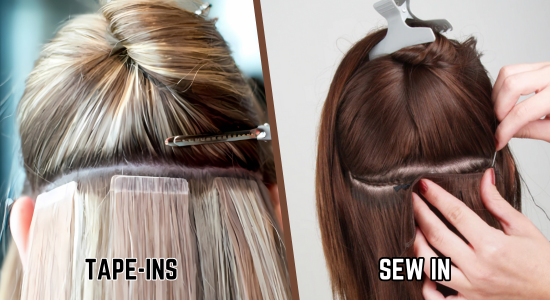
Trying to figure out whether tape-in hair extensions or sew-ins are right for you? Let’s break it down in simple terms, because while both give you stunning length and volume, they work best for different hair types and lifestyles.
Tape in extensions are quick to apply (about an hour), lightweight, and last 6–8 weeks. They lie flat against the scalp and blend beautifully—perfect for fine to medium hair.
Sew-ins (or weaves) take longer—around 2–4 hours—and involve braiding your natural hair, then sewing in the extensions. They’re very secure and can last up to 10 weeks, making them ideal for thick, textured hair.
That said, sew-ins can feel tight and may cause tension or breakage if not fitted properly. Tape-ins are gentler on the scalp and more versatile day to day, though they’re not great for high ponytails, as the tapes can occasionally show.
Sew-ins are brilliant for those with thick, textured hair who want a strong, long-lasting protective style. But if you’re looking for something lighter, quicker to apply, and more versatile day to day, tape-in hair extensions are the clear winner.
Who Are Tape In Hair Extensions Best For?
Tape-ins are ideal for anyone who wants long, voluminous hair without committing to a permanent method. They’re especially well-suited for:
- People with fine to medium hair who want something lightweight
- Busy individuals who want a semi-permanent option without lengthy salon visits
- Those who want a natural finish without obvious extension bonds
- Style enthusiasts who love experimenting with lengths, waves, or colours without damaging their own hair
They’re not the best fit if you’re constantly at the gym, swim regularly, or love using oils and serums—all of which can affect the adhesive.
Top Tips for Getting the Most Out of Tape In Hair Extensions
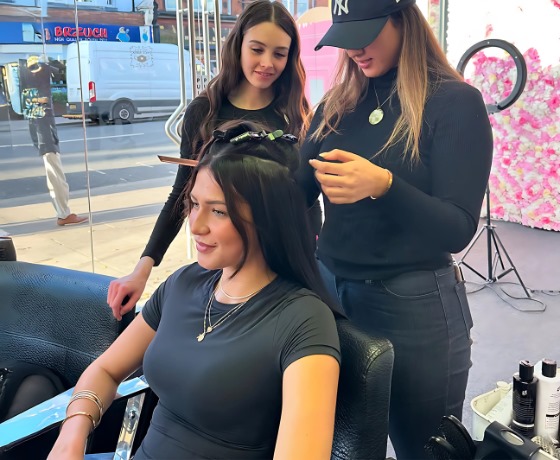
- Always go to a professional stylist for application and removal—DIY jobs can go very wrong.
- Avoid oil-based products near the roots or tape area.
- Brush gently with a loop brush or extension-safe detangler.
- Sleep with your hair in a loose plait or silk bonnet to prevent tangling.
Use extension-safe shampoo and conditioner to maintain adhesive and shine.

Are Tape In Hair Extensions Worth It?
In short—yes, absolutely, if you’re after a gorgeous, natural-looking mane with minimal fuss.
Tape in hair extensions strike a great balance between commitment, comfort, and style. They offer a sleek finish that blends well, don’t take hours to apply, and can be reused with proper care. While they do require a bit of maintenance and a few lifestyle adjustments, most wearers find them a fantastic investment in their hair confidence.
If you’re torn between options, tape-ins are often the perfect middle ground—not too temporary, not too permanent. Just right.

